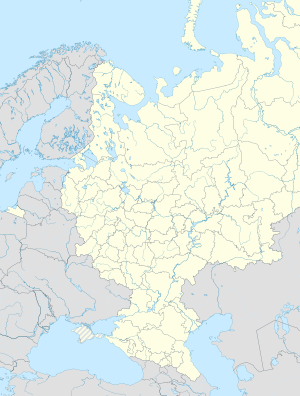TUBSAT-N / N1
| TUBSAT-N and TUBSAT-N1 | |
|---|---|
| Type: | Technology testing satellites |
| Country: |
|
| Operator: | ILR |
| COSPAR-ID : | • 1998-042A • 1998-042B |
| Mission dates | |
| Dimensions: | • 8.5 kg • 3 kg |
| Size: | • 32 × 32 × 10.4 cm • 32 × 32 × 3.4 cm |
| Begin: | July 7, 1998, 03:15 UTC |
| Starting place: | Barents Sea |
| Launcher: | Shtil-1N |
| Status: | • burned up on April 23, 2002 • burned up on October 21, 2000 |
| Orbit data | |
| Rotation time : | 96.4 min |
| Orbit inclination : | 80 ° |
| Apogee height : | 770 km |
| Perigee height : | 400 km |
Location of the submarine K-407 Novomoskovsk at the launch of TUBSAT N and TUBSAT N1 |
TUBSAT-N and N1 were the first nanosatellites from the Institute for Aerospace ( ILR ) at TU Berlin . The ILR took on the development and construction of the satellites, with Udo Renner as the project manager, and the funding was provided by the Federal Ministry of Education and Research . The satellites were communications and technology testing satellites.
The satellites were launched as a coupled system and were only separated from each other in orbit. The idea was to stack up to ten TUBSAT-N1 satellites in order to launch them together and only separate them into independent platforms in orbit. Each of the sub-satellites could have taken on their own tasks. However, the money was only enough for two satellites.
Mission history
The launch took place on July 7, 1998 with a Russian Shtil-1N rocket. For the first time satellites were brought into orbit by a submerged submarine, the K-407 Novomoskowsk . The launch site was off the Kola peninsula in the Barents Sea .
The communication experiments essentially corresponded to those of the TUBSAT-A but with more modern technology and significantly reduced volume and mass requirements. The scheduled re-entry into the atmosphere took place a year later.
Technical specifications
TUBSAT-N: 32 x 32 x 10.4 cm, 8.5 kg
- UHF communication system
- 1 reaction wheel
- 1 star sensor
TUBSAT-N1: 32 x 32 x 3.4 cm, 3 kg
- UHF communication system
See also
Web links
- ILR: TUBSAT-N / N1 (English)
- Tubsat in the Encyclopedia Astronautica (English)
